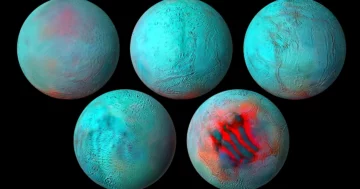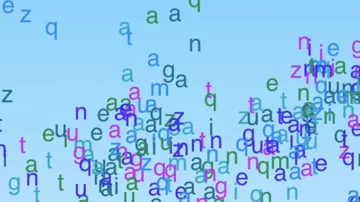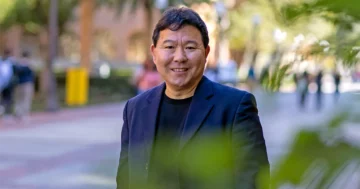
Introduction
When the paleontologist Michael D’Emic cut into the bones of Majungasaurus, a relative of Tyrannosaurus rex that roamed Madagascar 70 million years ago, he suspected that surprises might be hiding in them. But what he found defied all expectations.
Majungasaurus adults measured up to 7 meters from snout to tail and could weigh 1,000 kilograms. Paleontologists had thought that big dinosaurs like these massive carnivores achieved their stature through rapid growth spurts. But the fossil bones revealed a different story. “Unlike carnivorous dinosaurs that had been studied up until then,” D’Emic said, the Majungasaurus grew “really, really slowly.”
Puzzled, he sliced up a close relative of the dinosaur — a Ceratosaurus from North America, which was roughly the same length and weight — to see if it grew slowly too. This time, “we got the opposite result,” he said. “It grew just about faster than any carnivorous dinosaur I’ve ever seen.”
What followed for D’Emic was a decade-long whirlwind of peering at bones for clues to how dinosaurs grew. His analysis of 42 different dinosaur species, recently published in Science, demonstrates that the “get big fast” mode of growth was less predominant than researchers have assumed.
It’s an insight that researchers think may be relevant to modern animals of all sizes, and not just to prehistoric behemoths. “It’s just as easy for an animal to evolve larger body size by growing slower for longer than it is growing faster,” said D’Emic, an associate professor of biology at Adelphi University in New York.
Whether an animal grows quicker and faster or slower and longer might seem like a nitpicky distinction. But an animal’s growth trajectory provides insights into its life and the world it inhabited. Fast-growing animals can overpower potential predators and outcompete other species, but they need plenty of food and other resources. Growing slowly is riskier, but it allows an animal to survive on less during hard times. The bones of Majungasaurus, for example, confirm that, as the top predator in its ancient ecosystem, it had the luxury of developing at a leisurely pace.
Understanding growth strategies also helps explain why some dinosaurs got enormous while others stayed small. Body size can affect everything from how long an animal lives to how many offspring it has, explained Santiago Herrera Álvarez, an evolutionary biologist and doctoral student at the University of Chicago. Yet, “surprisingly, we don’t have a lot of information [about] the key developmental or genetic mechanisms underlying body size variation across animals,” he said. Studies like D’Emic’s start to open that black box.
Breaking Bones
Bones contain secrets about an animal’s life history. Holes left behind by long-gone blood vessels can reveal a creature’s metabolic rate. Miniature dimples in bone that form during healing hint at trauma from ancient battles. Thin lines within a bone — much like growth rings in a tree — can indicate the age of an animal by marking where the growth of the cortical bone slowed or stopped for annual dry seasons or winters.
With bones, “we can watch our dinosaurs grow,” said P. Martin Sander, a paleontologist at the University of Bonn in Germany who was not part of the research. “The only decent way of inferring or even observing how that dinosaur grew is with its own microstructure.”
To get the answers he wanted, D’Emic therefore turned to paleohistology — the study of fossil tissues under the microscope. Its techniques haven’t changed much in nearly two centuries: Cutting through ancient bones requires intensive labor, usually with a diamond blade like that of a jeweler. Museums can be reluctant to hand over their fossils for such destructive analysis but that’s started to change in recent decades. In exchange for “what is in many ways the most boring part of the bone … you’re gaining this amazing window into how the animal lived,” D’Emic said.
Over several years, D’Emic and his colleagues analyzed more than 80 bones from 42 species of theropods, the two-legged, mostly carnivorous dinosaurs that lived between 66 million and 230 million years ago and gave rise to birds. In life, those dinosaurs ranged in size from house cat to T. rex. The wafers of bone that the researchers extracted, some about as wide as a hockey puck, had to be sanded down to a thickness of one-tenth of a millimeter — thin enough to see through, but not thin enough to break. Even then, the growth rings were too narrow to be examined effectively by eye. “You’re trying to see things that are a tenth of the thickness of a hair,” D’Emic said. Only by overlaying hundreds of images at different magnifications could the researchers get the measurements they needed.
In each bone slice, the researchers looked for the biggest gap between rings to find the year when the animal grew the most. That maximum annual growth rate was compared with the dinosaur’s body mass, which they inferred from the size of the femur and shin bones. Then the team looked closely at the evolutionary trends in size versus growth rates within different lineages.
About 60% of the sampled theropod species were bigger than their ancestors. But among them, D’Emic’s bone analysis revealed a nearly even split between species that grew faster than their ancestors and species that grew for longer. The preferred strategy didn’t limit how much bigger the theropods became. Some tyrannosaurs, for example, increased their body mass by more than 200% in a single year, while others eventually achieved a similar mass by growing over more years.
The same was true among the 40% of species that shrank: About half were smaller than their ancestors because they grew more slowly and half because they grew for less time.
There was no overall trend of theropod lineages getting bigger or smaller throughout their evolution — with one exception. In the lineage that led to birds, the new analysis found a consistent decrease in the maximum annual growth rate. That tendency presumably contributed to their shrinking — a change that eventually helped some theropods get small enough to fly.
“A Tyrannosaurus is somehow ancestral to a bird,” Sander said. “You have to make it smaller.”
Paths of Least Resistance
Past studies have often suggested that a fast peak growth rate is the key to size in dinosaurs, birds and mammals. But the new analysis found that theropods were instead just as likely to control the duration of their growth — an alternative strategy previously identified in only a few groups, including crocodiles and some lizards.
What D’Emic and his colleagues found in theropods might eventually turn out to be more the rule than the exception. In their paper, they noted that previous studies of growth strategies have often been limited comparisons of a few species rather than comprehensive studies of lineages.
“My hunch would be that once other groups of animals are studied, we’re going to find the same thing,” he said. “We’re going to find that evolution just takes the path of least resistance” and uses whatever strategy is easiest.
Kevin Padian, a paleontologist at the University of California, Berkeley, agreed that variability in growth strategies is to be expected since the needs and environmental constraints on every animal are different. “Each species does its own thing, and its growth strategy reflects that,” he said in an email. It will be good, he added, to duplicate D’Emic’s theropod project in other vertebrate groups.
D’Emic thinks of his work as a jumping-off point for many new directions. He’s now studying pantodonts, an extinct group of hippo-like mammals that rapidly evolved to be gigantic right after the dinosaurs went extinct and right before a period of intense global warming. Figuring out how climate change affects growth rate and size could potentially have implications for modern conservation, he said.
Sander is interested in how these growth strategies relate to metabolic rate. “For me, this is also the justification for studying dinosaurs, not just because they’re cool and extinct, but because this kind of work extends the range of what we see in living animals,” he said.
- SEO Powered Content & PR Distribution. Get Amplified Today.
- Platoblockchain. Web3 Metaverse Intelligence. Knowledge Amplified. Access Here.
- Source: https://www.quantamagazine.org/dinosaur-bone-study-reveals-that-not-all-giants-grew-alike-20230320/
- :is
- ][p
- $UP
- 000
- 1
- 2021
- 7
- 70
- a
- About
- achieved
- across
- added
- adults
- affect
- After
- All
- allows
- alternative
- amazing
- america
- among
- analysis
- Ancient
- and
- animal
- animals
- annual
- answers
- ARE
- AS
- Associate
- assumed
- At
- BE
- because
- before
- Behemoths
- behind
- Berkeley
- between
- Big
- bigger
- Biggest
- biology
- Birds
- Black
- BLADE
- blood
- body
- BONE
- Boring
- Box
- Break
- by
- california
- CAN
- CAT
- change
- chicago
- Climate
- Climate change
- Close
- closely
- colleagues
- compared
- comprehensive
- Confirm
- CONSERVATION
- consistent
- constraints
- contributed
- control
- Cool
- could
- Cut
- cutting
- decades
- decrease
- demonstrates
- developing
- developmental
- Diamond
- different
- dinosaur
- Dinosaurs
- Dont
- down
- dry
- during
- each
- easiest
- easy
- ecosystem
- effectively
- enormous
- enough
- environmental
- Even
- eventually
- EVER
- Every
- everything
- evolution
- evolve
- evolved
- example
- exception
- exchange
- expectations
- expected
- Explain
- explained
- eye
- FAST
- faster
- few
- Find
- followed
- food
- For
- form
- Fossils
- found
- from
- gaining
- gap
- Germany
- get
- getting
- Global
- global warming
- going
- good
- Group
- Group’s
- Grow
- Growing
- Grows
- Growth
- Hair
- Half
- hand
- Hard
- Have
- helped
- helps
- history
- Holes
- House
- How
- HTTPS
- Hundreds
- identified
- images
- implications
- in
- In other
- Including
- increased
- indicate
- information
- insight
- insights
- instead
- interested
- IT
- ITS
- jpg
- Key
- Kind
- labor
- larger
- Led
- Length
- Life
- like
- likely
- LIMIT
- Limited
- lines
- Lives
- living
- Long
- longer
- looked
- Lot
- Luxury
- make
- many
- Martin
- Mass
- massive
- maximum
- measurements
- Microscope
- might
- million
- Mode
- Modern
- more
- most
- Museums
- nearly
- Need
- needed
- needs
- New
- New York
- North
- north america
- noted
- of
- on
- ONE
- open
- opposite
- Other
- Others
- overall
- own
- Pace
- Paper
- part
- path
- Peak
- period
- PHP
- plato
- Plato Data Intelligence
- PlatoData
- Plenty
- Point
- potential
- potentially
- predator
- predators
- preferred
- previous
- previously
- Professor
- project
- provides
- published
- Quantamagazine
- quicker
- range
- rapid
- rapidly
- Rate
- Rates
- rather
- recent
- recently
- reflects
- relevant
- requires
- research
- researchers
- Resources
- result
- reveal
- Revealed
- Reveals
- Rise
- roughly
- Rule
- Said
- same
- Science
- seasons
- several
- similar
- since
- single
- Size
- sizes
- Slice
- Slowly
- small
- smaller
- some
- split
- start
- started
- stayed
- stopped
- Story
- strategies
- Strategy
- Student
- studied
- studies
- Study
- Studying
- such
- surprises
- survive
- suspected
- takes
- team
- techniques
- that
- The
- the world
- their
- Them
- therefore
- These
- thing
- things
- Think
- Thinks
- thought
- Through
- throughout
- time
- times
- tissues
- to
- too
- top
- trajectory
- Trend
- Trends
- true
- TURN
- Turned
- under
- underlying
- university
- University of California
- University of Chicago
- usually
- Versus
- wanted
- Watch
- Way..
- ways
- weigh
- weight
- What
- which
- while
- WHO
- wide
- will
- with
- within
- Work
- world
- would
- year
- years
- zephyrnet










